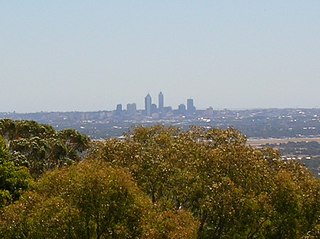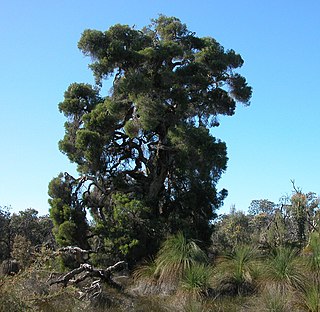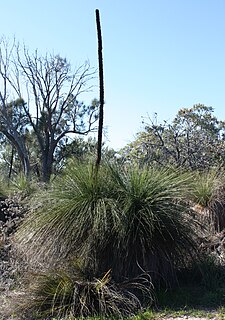
Banksia ilicifolia, commonly known as holly-leaved banksia, is a tree in the family Proteaceae. Endemic to southwest Western Australia, it belongs to Banksia subg. Isostylis, a subgenus of three closely related Banksia species with inflorescences that are dome-shaped heads rather than characteristic Banksia flower spikes. It is generally a tree up to 10 metres (33 ft) tall with a columnar or irregular habit. Both the scientific and common names arise from the similarity of its foliage to that of the English holly Ilex aquifolium; the glossy green leaves generally have very prickly serrated margins, although some plants lack toothed leaves. The inflorescences are initially yellow but become red-tinged with maturity; this acts as a signal to alert birds that the flowers have opened and nectar is available.

The Swan Coastal Plain in Western Australia is the geographic feature which contains the Swan River as it travels west to the Indian Ocean. The coastal plain continues well beyond the boundaries of the Swan River and its tributaries, as a geological and biological zone, one of Western Australia's Interim Biogeographic Regionalisation for Australia (IBRA) regions. It is also one of the distinct physiographic provinces of the larger West Australian Shield division.

Eucalyptus gomphocephala, known as tuart, is a species of tree, one of the six forest giants of Southwest Australia. Tuart forest was common on the Swan coastal plain, until the valuable trees were felled for export and displaced by the urban development around Perth, Western Australia. The wood is dense, hard, water resistant and resists splintering, and found many uses when it was available. Remnants of tuart forest occur in state reserves and parks, the tree has occasionally been introduced to other regions of Australia and overseas. Remaining trees are vulnerable to phytophthora dieback, an often fatal disorder, including a previously unknown species discovered during analysis of dead specimens.

Melaleuca preissiana, commonly known as stout paperbark, modong or moonah, is a plant in the myrtle family, Myrtaceae and is endemic to coastal areas of southwest Australia. It is a shrub or small tree with papery bark, small leaves and spikes of usually white flowers. It occurs chiefly in areas that are seasonally wet.

The western swamp turtle, also known as the western swamp tortoise, is a short-necked freshwater turtle that is the sister taxon to all other members of the subfamily Chelodininae. As a consequence of the greatly altered ecology in the region around Perth, Western Australia, where it exists in fragmented populations, the species is critically endangered by extinction.

The Gnangara Mound is an area north of Perth, Western Australia where a large mound of sandy soil reaches an elevation of about 60 metres (200 ft). It stores about 20 cubic kilometres of fresh water, about one hundred times Perth's current annual water usage. It is currently the single most important source of potable water for the city. Together with the Jandakot Mound south of Perth it supplies about 35%-50% of the city's drinking water.

Neopasiphae simplicior, a native bee, is an endangered species found near Perth, Western Australia. Body is creamy yellow and brown, 7 mm long and wings up to 5 mm long. The Swan Coastal Plain has undergone agricultural and suburban development which has reduced the range and threatens the species with extinction. It has been collected at Cannington and the Forrestdale golf course. The species has been found on Lobelia tenuior, Goodenia filiformis and Angianthus preissianus.
The Yarragadee Aquifer is a significant freshwater aquifer located in the south west of Western Australia and predominantly beneath the Swan Coastal Plain west of the Darling Scarp. It has a north-south range from about Geraldton to the south coast, but with a split in the formation south of Perth. The southern part is known as the South West Yarragadee Aquifer.
Forrestdale Lake Nature Reserve is a lake nature reserve around Forrestdale Lake in the City of Armadale, Western Australia, approximately 25 kilometres (16 mi) south of the central business district of Perth, the state capital, and on the southern fringes of the Perth metropolitan area. It lies immediately south of the suburb of Forrestdale, and 8 kilometres (5.0 mi) south-east of Jandakot Airport. It is a still largely natural wetland, with some adjoining native vegetation, surrounded by land developed for housing and agriculture, that regularly supports large numbers of shorebirds and other waterbirds.

Xanthorrhoea preissii, known as balga, is a widespread species of perennial monocot in Southwest Australia.

The Paroo-Darling National Park is a protected national park that is located in the Far West region of New South Wales, in eastern Australia. The 178,053-hectare (439,980-acre) national park spans two distinct regions in the outback area. This region covers the arid catchments of the Paroo River and the Paroo-Darling confluence to the south.
Thomsons Lake Nature Reserve is a lake nature reserve around Thomsons Lake in the City of Cockburn, Western Australia, approximately 25 kilometres (16 mi) south of the central business district of Perth, the state capital, and on the southern fringes of the Perth metropolitan area. It is in the suburb of Beeliar, 7 kilometres (4.3 mi) south-west of Jandakot Airport. It is a still largely natural wetland, with adjoining native vegetation, surrounded by land developed for housing and agriculture, that regularly supports large numbers of shorebirds and other waterbirds.
The Leederville Aquifer is a significant freshwater aquifer located in the south west of Western Australia and predominantly beneath the Swan Coastal Plain west of the Darling Scarp.

Regelia ciliata is a plant in the myrtle family, Myrtaceae and is endemic to the south-west of Western Australia. It is a rigid, spreading shrub with paper-like bark on the stems, tiny wedge shaped leaves and dense heads of mauve flowers in spring and summer.

Darwinia foetida, commonly known as Muchea bell, is a plant in the myrtle family Myrtaceae, and is endemic to Western Australia. It is a small upright shrub with greenish coloured nodding flowers at the apex of the stems, that have an unpleasant odour. This is a very restricted species, known from only a couple of locations.
Corymbia calophylla – Xanthorrhoea preissii woodlands and shrublands of the Swan Coastal Plain is an ecological community in the Southwest Australia ecoregion.

Kensington bushland reserve is a significant remnant of Swan Coastal Plain vegetation, that has been reserved in the suburb of Kensington, in Perth, Western Australia, by the state government.

Elizabeth Springs is a heritage-listed artesian springs in Diamantina Lakes, Shire of Diamantina, Queensland, Australia. It is one of the springs of the Great Artesian Basin (GAB). It was added to the Australian National Heritage List on 4 August 2009.












